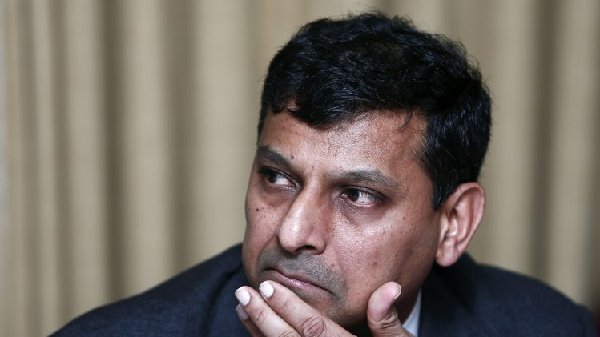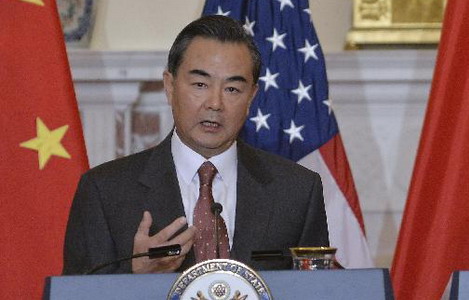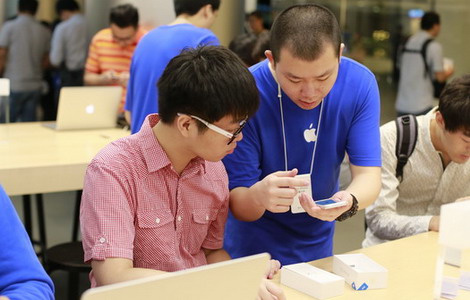India's new central banker hikes rates
Updated: 2013-09-20 18:18
(Agencies)
|
||||||||
|
 Reserve Bank of India (RBI) Governor Raghuram Rajan listens to a question during a news conference after the mid-quarter monetary policy review at the RBI headquarters in Mumbai September 20, 2013. [Photo by Reuters] |
MUMBAI — India's new central bank chief unexpectedly raised interest rates Friday, putting a higher priority on taming stubbornly high inflation than bowing to pressure to juice the struggling economy with cheap credit.
Asia's third-largest economy has been looking to respected former IMF chief economist Raghuram Rajan to rescue it from slow growth, high inflation and a weakened currency. He has been governor of the Reserve Bank of India for less than a month but already has been hailed as a rock star in local media.
But his tough love approach to monetary policy in his first review of interest rates will put the onus on India's politicians to fix deep-seated problems in the economy. He raised the benchmark interest rate at which banks borrow from the central bank by a quarter percentage point to 7.5 percent.
The surprise rate hike sent Indian stocks into a tailspin. The Sensex index was down 2.2 percent.
A longtime University of Chicago professor known for having predicted the 2008 global financial crisis, Rajan's steadying voice of authority had in recent weeks given a boost to investor confidence in India. But the central bank has limited scope in addressing India's economic woes. Rajan's greatest potential contribution might lie in whether he can use his credentials and international standing to coax India's government into reforming policies that he identifies as the underlying cause of the country's economic doldrums.
Rajan's statements after the policy announcement suggested he is working with the government to stabilize the rupee and supporting their efforts to attract more foreign investment and narrow India's worrisome current account and budget deficits. He met with Finance Minister Palaniappan Chidambaram and Prime Minister Manmohan Singh earlier in the week.
He also warned that the US Federal Reserve's surprise decision this week to refrain from scaling back its monetary stimulus, which had the side effect of reducing pressure on the rupee, is only a temporary reprieve and should be used as a window of opportunity.
"We must use this time to create a bullet-proof national balance sheet and growth agenda which creates confidence in citizens and investors alike," Rajan said.
At the Reserve Bank, Rajan faces a tough, ongoing balancing act of trying to stimulate growth while keeping inflation in check. Businesses would have liked him to cut interest rates to try to boost consumption and kick-start flagging economic growth. The economy expanded 4.4 percent in the April-June quarter, far below the average of 8 percent growth of just a few years ago.
But making borrowing cheaper risks worsening inflation, which climbed to 6.1 percent in August, exceeding the 4.5 percent rate that the Reserve Bank has set as a target. For the millions of Indians who get by on less than $2 per day, such price increases, especially for food, are a major hardship.
"They really are in a bind," said Anjalika Bardalai, an analyst for Eurasia Group. "There are a lot of different economic indicators that are not looking very good. And quite frankly, there is no single set of policies that is going to fix all the problems at once."
To soften the blow of the interest rate hike, Rajan announced that emergency measures taken in July to restrict the money supply and stabilize the currency were being eased, which should provide some stimulus for the economy.
India is suffering a host of economic problems: poor infrastructure and stubborn inflation that keeps interest rates high, dependence on imported fuel, a current account deficit due to low exports and high imports, and fragile confidence that has deterred business investment. Plus, the government's budget is in deficit thanks to costly fuel subsidies and the fiscal position is likely to deteriorate because of the looming cost of a new law guaranteeing food for the poor.
To make matters worse, many foreign investors had been pulling out of India and other emerging markets because of expectations the Federal Reserve would scale back its easy credit policy that had sent "hot money" into riskier developing markets in search of higher returns. The Fed surprised many Wednesday by keeping the easy money going for now. Stocks in India and other emerging markets rebounded but the withdrawal of stimulus is only a matter of time and is likely to roil world markets again.
Rajan took office on Sept. 4 at a low point, after a month of plunging stocks and a week after the rupee hit a lifetime low of 68.8 against the dollar. He surprised almost everyone by immediately announcing short-term measures aimed at boosting confidence. He said that banks would be allowed to open new branches without going to the RBI for permission and offered a "swap window" for banks holding US dollar liabilities to exchange them at a lower-than-market rate of 3.5 percent; analysts at Barclays predicted the latter move could attract $10 billion in foreign currency inflows, bolstering the rupee and easing current account pressures.
The next day, both the rupee and the Sensex stock index surged, and the Indian media swooned. One commentary in the financial daily Mint depicted Rajan as both swaggering like a Bollywood star and flying through air like a super-hero.
The "Rajan effect" may be short-lived, however, since India's fundamental problems remain and he is limited mostly to the blunt instrument of setting interest rates.
Plus, Rajan himself wrote in a recent article that the true solutions for the economy are making it easier to do business in India by improving infrastructure, easing regulations that slow down investment, reducing subsidies for fuel and reining in double deficits in the national budget and current account. These are all tasks that are the responsibility not of the Reserve Bank, but of the central government.
Part of his task as India's rescuer-in-chief may be to leverage his reputation and popularity to try to persuade his counterparts in government to enact politically sensitive reforms, even as a looming election in May makes it particularly difficult.
"Given his status in the US and the world, he may indeed be able to influence the government," said Moody's economist Glenn Levine. "It may not be by a huge amount, because political realities will not shift, but the fact that he is a well-respected global economics professor may carry weight."

 China to play 'constructive' role on Syria: FM
China to play 'constructive' role on Syria: FM
 iPhone 5s, iPhone 5c hit Chinese market
iPhone 5s, iPhone 5c hit Chinese market
 Faces of Tibet
Faces of Tibet
 Full moon across China
Full moon across China
 Wearable technology, the new game-changer
Wearable technology, the new game-changer
 Tapestry of Chinese culture and a Harvard teen's feeling
Tapestry of Chinese culture and a Harvard teen's feeling
 A simple but pure festival tradition
A simple but pure festival tradition
 Parents told to think before clicking 'send'
Parents told to think before clicking 'send'
Most Viewed
Editor's Picks

|

|

|

|

|

|
Today's Top News
UN lauds China on food waste efforts
Chinese firms face trust deficit
13 injured in Chicago park shooting
Wang and Kerry meet in DC
Belgian zoo owner set to host Chinese pandas
Trending news across China
Fast-track process sees more NGOs
Beijing sends out positive smoke signals
US Weekly

|

|





